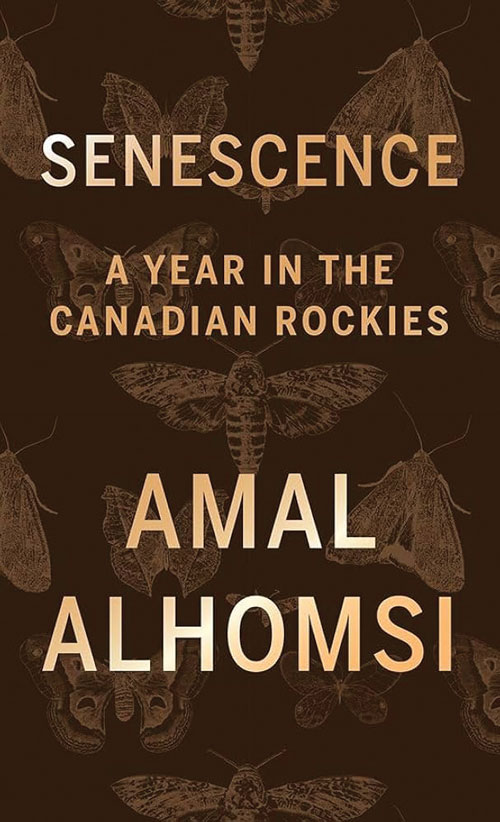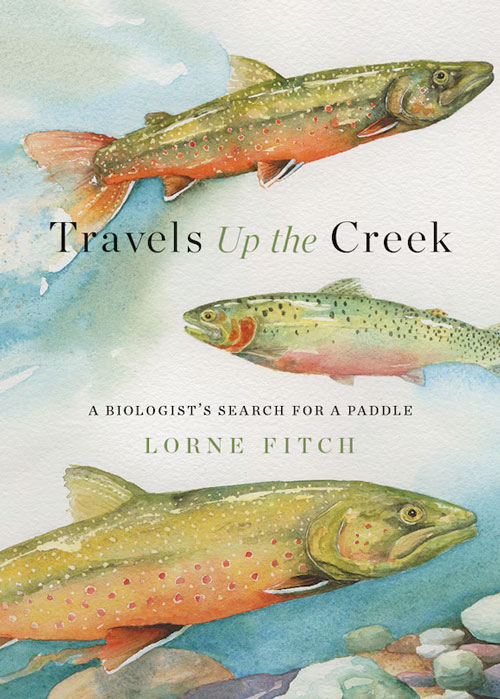Both Senescence: A Year in the Canadian Rockies, by Amal Alhomsi, and Travels Up the Creek: A Biologist’s Search for a Paddle, by Lorne Fitch, published by Rocky Mountain Books in the fall of 2024, are thoughtful and passionate engagements with the mountains and prairies of Alberta. Although Alhomsi and Fitch are devoted to similar landscapes, their approach to the land and to the environmental concerns at the centre of their books, as well as the language they employ in connecting to place, couldn’t be more different.
Senescence explores the process of aging and setting down new roots in a place when one has come from another landscape entirely. Alhomsi is a Syrian writer and artist who has lived in Banff since 2018. His debut book is written in layered, lyric dialogue with the land and water; at the same time, it is in constant conversation with other writers and thinkers whose work explores the natural and the spiritual. Considering the state of a heat dome summer, the Bow Valley landscape around him turning sere and brittle, he reflects, “Nearly 40 degrees C. Nearly Riyadh’s weather. I would look at a tree and wonder: How is it not on fire? Is it not just dry sap and timber? I have never seen things rattle without being touched by wind. Natalie Rice writes, ‘Grass is a fire / before it knows it is a fire.’ So are the mayflies, so is this body; lumps of damp mud left until they turn into tar, until they’re burnt out of their clinging.” The language in Senescence is exquisite, delving into the intimate connections between the human and the more-than-human, forging elegant links between the aging body and the land suffering through the climate crisis.
Alhomsi’s language may be rich with image and sound play, but it loses none of its power to convince. This is a book exploring the gorgeousness of the earth, but it’s also one that looks clear-eyed at the devastation wrought upon the land—in particular, by those nations whose primary drive is to consume, and at the more-than-human world that pays the price of that hunger. Alhomsi warns, “Since the 1500s, over 140 species of birds have gone extinct, 80 mammals, 10 per cent of all insects, and around 600 plants. There seems to be not enough world for what we want from the world. These horrifying statistics are not, as many believe, an accidental consequence of industrialization or pollution. They are as purposeful and methodical as tides.” As readers, we find ourselves drawn in by the sensuousness of the author’s language, and we quickly come to understand that it is underlain by a keen intellect constantly aware of the larger world.
Similar in focus but vastly different in register, Lorne Fitch’s Travels Up the Creek uplifts both land and community from the perspective of a professional biologist and co-founder of the riparian stewardship organization Cows & Fish. Over his long career in Alberta, Fitch has forged deep connections with communities of ranchers, farmers and researchers. Travels Up the Creek is both a celebration of the land—from places such as Hidden Creek in the eastern slopes through to the prairies and forests into which the mountain streams and rivers flow—and an unveiled look at the impacts of the climate crisis and the devaluation of scientific inquiry. Fitch is equally adept at recounting stories of the lands he’s known and worked with much of his life as he is at calling for awareness of political grandstanding and social media misinformation; the book blends research and narrative with aplomb. A story well told and intelligently and accurately sourced, he argues, can prove compelling to those who have not yet decided to take action in their own lives in support of the land: “Stories tell truths about place and the ways place can affect us. Our minds are shaped by place, as they are by our genes. Stories are the threads that connect our intellect, locate common ground and find the linkages between our history and our future. Richard Kearney wrote, ‘Telling stories is as basic to human beings as eating. More so, in fact, for while food makes us live, stories are what make our lives worth living.’ Maybe they can help us treasure the place where we live and treat it kindlier.”
Toward this, Fitch recounts many of his own experiences with community (both human and more-than-human), from the rivers and fish to those whose work is intimately linked to the health of the nearby waterways. He’s generous with his stories of learning from the land and from the farming and ranching communities around him, and realistic in terms of the impacts of the changing climate on these same lands and communities. But he doesn’t leave the reader in the gloom without rescue. The book itself is the proverbial paddle in its title, an informed and thoughtful steering mechanism to help us right ourselves and move toward a more sustainable future. “If the contents of this book help educate you on environmental issues, inspire you, anger you and ultimately motivate you to act,” he writes, “my job is temporarily done.”
Alhomsi’s and Fitch’s books take different approaches and stem from different communities, but both are deeply grounded in engagement with the more-than-human world. Ultimately, both authors alight on the same point: that close attention to the world is imperative, and that even at this late date, there’s still time to lean in, attend and change.
Jenna Butler is an author and scholar near Barrhead. Her most recent book is Revery: A Year of Bees (Wolsak & Wynn).
_______________________________________



